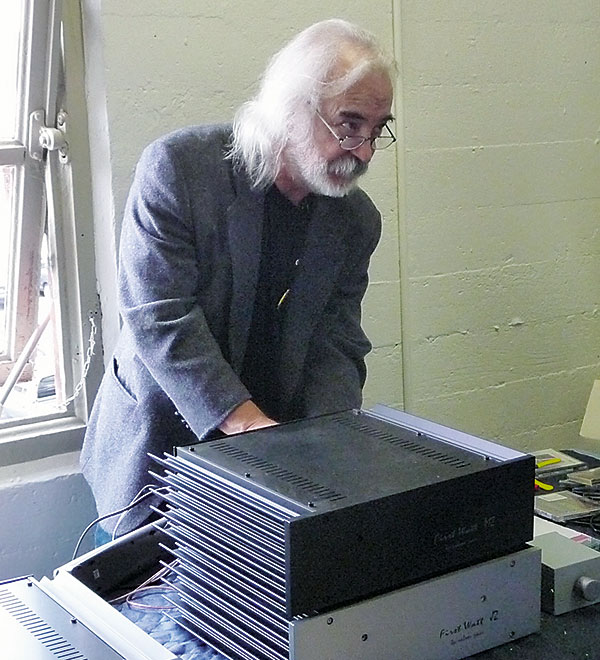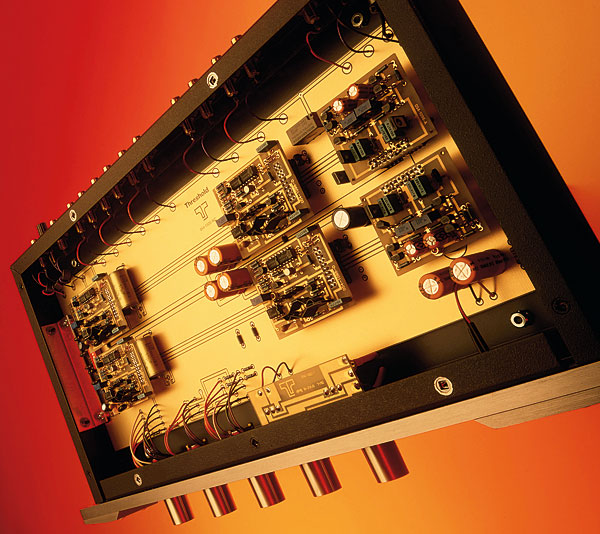Threshold pre/power Page 2
![]() Sweet And Low
Sweet And Low
It has to be said from the outset that the sound quality of the SA/3.9e was not in the Krell or ARC class, and yet as the listening test continued the amp did generate a good level of creditability, establishing it as a fine second-rank design. Its musical approach was in its favour and it never sounded mean or thin, hard or fatiguing. The nearest it came to perceived distortion or colouration was a slight brittleness in the treble – a touch of extra sharpness on cymbals and on rim-shot percussion.
Belying its modest power spec, the Threshold power amp always sounded effortless and big-hearted and its fundamental quality remained constant regardless of loading or volume level. Big climaxes were conveyed without false drama or strain, the amp unruffled by the dynamics of the music it was handling. Stereo images were well formed, with good width and focus accompanied by a good measure of depth. Ambience was nicely portrayed, and the effect was both spacious and atmospheric on appropriate recordings.

The bass was impressive for its weight and extension, though it was tending to mild excess and softness in absolute terms. By state-of-the-art standards it was somewhat slowed and heavy, undesirable with an Apogee speaker for example, and more suited to the drier bass of the KEF R105 III. In the midrange the SA/3.9e showed some 'character' in the form of a loss of accuracy. Vocal solos were well projected and almost spot-lit, without any serious tonal imbalance or colouration, yet mid transients were felt to be a little rounded off, while a mild loss of clarity and transparency was apparent.
In the upper treble it sounded pleasant – a tidy rendition with no obvious frequency imbalances or distortion. The overall effect was of a sound that was sweeter and more measured than it should have been. Large-scale classical works were nonetheless handled with great competence, though smaller jazz and rock combinations lost some of their inherent energy and pace.
It could play loudly, rather more than the 60W specification suggested, and this is indicative of good clipping behaviour, resulting from a beneficially low NFB design. Performance rivalled that of many established great amps, but a few notches below the state-of-art.
Grand Slam
As for the FET nine.e preamp, and working with the line stage first, a major feature was its compatibility with the power amp, both in merit and character. Like the SA/3.9e, it had a rich, slightly emphasised bass, but despite this the low frequency register was tuneful and interesting, exhibiting good slam and extension to the lowest frequencies.

While not entirely neutral, the mid register did seem balanced, a richer almost dreary foundation countered by a hint of electronic nasality in the upper range of vocals. The mid was judged to be expressive and showed natural transients well. In the treble, the line stage was distinguished by excellent precision, a touch rounded, dry rather than sparkling, but beautifully contained and free from sizzle or emphasis.
First impressions of its ability to reproduce fine detail were very good, and this quality remained until very low levels were reached, where finally there was a shortfall. It went a little 'dark' on the quietest fine detail, particularly in complex sound patterns. Likewise, it can provide a fine impression of depth and perspective, the depth ultimately constrained by the transparency limit. Transparency was good, close to the top rank, though not up with the very best. Stereo images were very well focused, showing good stability over varied listening levels and programme type.
A Little Romance
Another appealing aspect was a rewarding presentation of dynamics, the preamp successfully transmitting programme character, that ability to surprise and excite the listener when a sudden climax appears. Although the overall sound was a little coloured – perhaps I should say romantically tinted – the end result was wholly plausible.
Moving down the chain to the LP disc input, it was noted that the gain was not particularly high, nor was the noise level particularly low. Evidently low-output MC cartridges should be avoided, but good results were obtained with a medium-output model like the Koetsu RSII.

Colouration was moderate, the hint of 'nasality' a little more evident via the analogue disc input, while the rendition of ambience and space was perceptibly drier and more enclosed. The general standard held up well in the bass, while the mid and treble ranges remained free from obvious grain or similar distortions. With prolonged listening, this latter aspect proved to be of increasing value in avoiding listening fatigue. Good stereo images were produced – well focused and showing a decent degree of perspective. Stage width was fine and a good proportion of recorded reverberation was also available. As such, it would be hard to argue with its performance except by direct reference to significantly superior electronics such as the KSP-7B, bearing in mind the necessary increase in price.
The Threshold sound as expressed by these units is not absolutely neutral, yet it remains pleasingly musical. Its particular brew does not require the acceptance of a lazy or exaggerated treble or a thin midrange, while subjective distortion is consistently low. The FET nine.e preamp and SA/3.9e power amplifier were well suited to each other, and there would not be much point in seeking alternative combinations.
Touch Of Class
I am forced to weigh very carefully the value provided by this finely built pair of Threshold amplifiers, such is the fierce level of competition at the high-end these days. Taken overall, the value is nonetheless fairly good. The preamp, in particular, is a high-class example of the genre, easy to recommend and realistically priced. Finally, one is left with an impression of high integrity, in both build quality and musical reproduction, which is a favourable combination in this sector of the market.























































